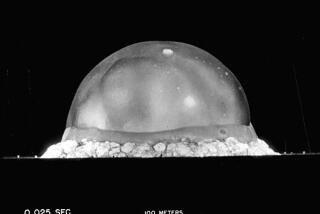The Map of Our History : HISTORICAL ATLAS OF THE UNITED STATES, CENTENNIAL EDITION <i> (National Geographic Society:$59.95; 289 pp.) </i>
- Share via
In 1982, the National Geographic Society decided to undertake the monstrously ambitious task of bringing out the first comprehensive historical atlas of the United States to have appeared in more than 50 years, or at least the first to have been written largely from a geographical perspective. The distinction is important. As a discipline, geography has obviously been subject to the same temporal and ideological biases that mark the writing of, say, narrative history or anthropology. Indeed, one has only to think of the standard map of the world, distributed until recently in the United States by the National Geographic Society itself, which distortedly presented the countries of the Northern Hemisphere as larger than those of the Southern. These maps gave generations of Americans the false impression that their country was larger than Brazil or, as it then was, the Congo.
Nevertheless, geography remains far more fixed in concrete reality, or, to put it another way, remains more of a science than a social science, because it proceeds not from what people have believed or said or even done so much as from the mute facts of the visible and the quantifiable.
In the United States, where in recent years angry debates over what should and should not be included in history textbooks have served to symbolize the larger ideological disputes that rend the country, the cooler rhetoric of geography is particularly welcome. Residents of Alaska and Hawaii may wince to see, yet again, their states preposterously reduced in size in the map of the United States that accompanies the volume, but, for the most part, the authors of the atlas have done an extraordinary job of distilling the vast amount of information they had to impart into a large book and, more important, of combining two not always linkable virtues in a book: fairness and subtlety.
Naturally enough, the atlas is upbeat in a way that Americans who feel less proud of the nation’s past--or less pleased by its present, not to speak of less sanguine about its future--will find simplistic. But the least one can say in defense of the book’s authors is that they are frank about their intentions. In his preface, Gilbert Grosvenor, the president of the National Geographic Society, states pointedly that “the atlas was conceived as our centennial gift (its publication coincides with the 100th anniversary of the society’s founding) to the nation, and in that spirit we offer it.” One could scarcely have expected a project of this kind to have replicated the views of those people in the country who remain subject to the temptation to spell America with a k or, for that matter, of that larger and more interesting group who simply see history as more tragic than triumphant.
That being said, the atlas is surprisingly modern and free of cant and piety. Often, the authors will describe a development and then go on to add that its results were not what might have been anticipated. In discussing the rise of mass communications and the spread of television, the authors conclude by observing that “one expected price--having regional speech homogenized by the networks--has not been exacted. Despite decades of television, Southerners, for example, still sound like Southerners and not like anchorpersons.” Even the organization of the book into sections titled “The Land,” “People,” “Boundaries,” “Economy,” “Networks,” and “Communities” imposes a degree of dispassion and something that is even harder to come by in too much of the United States these days: rationality.
When the last atlas of this kind was published, neither Hawaii nor Alaska had yet achieved statehood, the suburbanization of the country was still in its infancy, and immigration was in one of its rare periods of lull. These are precisely the sorts of changes that the book clarifies wonderfully. Unlike so many commentators and pundits, the authors seem to have a clear-eyed view of what is taking place in the United States, of the vertiginous changes that the country is undergoing. It is perhaps because of this that they have the wit to conclude the book with a survey of Los Angeles. “Los Angeles,” they write, has become “a city of immigrants,” a place that “has both recapitulated U.S. urban history and foreshadowed its future.”
The story the atlas tells is, to a large extent, one of homogenization and then, more recently, what must be called de-homogenization. Perhaps the success of the melting pot was always exaggerated. Certainly, the authors are at pains to point out the limits, even at the time, of assimilation among immigrants. Whatever the future of this process--and one cannot help feeling that the authors are right in arguing that Los Angeles will likely be where we will first get sense of what things will be like in 21st-Century America--the atlas is a wonderful vehicle for contemplating it. For if the “post-modern” world is changing at an increasingly rapid pace, nowhere has the change been more rapid than in the United States, which at times can, indeed, seem like the first post-modern country.
If there is, finally, something curious about the “Historical Atlas of the United States,” it is precisely because of something curious about the country itself. When the great French historian Fernand Braudel began at the end of his life to envisage a series of books to be called “The Identity of France,” he had, to say the least, an idea that he was talking about something fixed and in some deeper sense immutable. In his preface, Braudel, who was, after all, the founder of that most impersonal of historiographical tendencies, the Annales school says: “I have never ceased to think of a France buried deep inside itself, within its own heart, a France flowing along the contours of its age-old history, destined to continue, come what may.”
The problem in thinking about the United States is, to a large extent, the diametrical opposite of the one that inspired Braudel. For Americans, the problem is to find a link with the past, to conceive of themselves in a historical continuum. If the presiding idea of European history has been, whatever its fissures and its tragedies, continuity, the American idea has always been change. But even change has a history, as the authors of the “Historical Atlas of the United States” show us with such humane authority.
More to Read
Sign up for our Book Club newsletter
Get the latest news, events and more from the Los Angeles Times Book Club, and help us get L.A. reading and talking.
You may occasionally receive promotional content from the Los Angeles Times.










